3.10.1 Financial Stability
The institution’s recent financial history demonstrates financial stability.
JUDGMENT: ![]() Compliant
Compliant
STATEMENT OF RATIONALE FOR JUDGMENT OF COMPLIANCE
The institution is able to fulfill its mission by maintaining financial stability over a period of years. This includes the revenue stream, expenses, and capital investments, among others.
State and local funds in the form of state appropriations, ad valorem taxes, and tuition and fees are the main sources of revenues to fund operations. State appropriations decreased dramatically in 2011 and 2012. There was a corresponding reduction in spending during that time period in order to maintain positive growth unrestricted net assets and to fulfill the College’s mission. Biennial funding for the years 2013-2014 and 2014-2015 saw a turn around. This was due to the unification of all the Texas community colleges in approaching the legislature with a common funding plan – to introduce Student Success Points into funding methodology. In 2013-2014 state appropriations amounted to 26% of the College’s revenue.


Ad-valorem taxes represented 9% of the College’s revenue. Southwest Texas Junior College is a rural school with a limited tax base. Over the last 10 years the tax rate has been maintained at 13 cents per $100 of valuation. The College has seen an increase in tax value in the recent years due to the increase in valuation of property in Zavala County. This county is heavily involved in the Eagle Ford Shale oil production business and its values have increased. This increase is predicted to be stable for, at least, the next two decades.


Annual Financial Report Schedule C FY 2014
Annual Financial Report Schedule C FY 2013
Annual Financial Report Schedule C FY 2012
Annual Financial Report Schedule C FY 2011
Annual Financial Report Schedule C FY 2010
Tuition and fees, net of discounts, represents 16% of total revenues. Texas community colleges are required to report tuition and fees net of discounts (financial aid applied to tuition and fees). These revenues have shown steady growth.


Southwest Texas Junior College has worked diligently to provide an affordable education for its students. With an In-District tuition of $57 per semester credit hour (Out of District $110.00 and Non-Resident $140), SWTJC fall in line with state-wide averages. There has been one fee increase in the five year time period -- $3/SCH has been added and ear-marked for the Technology Fund . This fund provides the money for the purchase of technology that affects students, faculty, and staff on an institution-wide basis without regard to learning methods.
Annual Financial Report Schedule A FY 2014
Annual Financial Report Schedule A FY 2013
Annual Financial Report Schedule A FY 2012
Annual Financial Report Schedule A FY 2011
Annual Financial Report Schedule A FY 2010
A review of the College’s last five years of financial statements indicates that the College’s net assets available to fund current operations have increased each year.

Annual Financial Report Schedule D FY 2014
Annual Financial Report Schedule D FY 2013
Annual Financial Report Schedule D FY 2012
Annual Financial Report Schedule D FY 2011
Annual Financial Report Schedule D FY 2010

The rate of change in assets (without depreciation) decreased during the lean state appropriations year of 201, 2012, and 2013; but, total assets continue to climb at a steady, deliberate pace. With the advent of a new administration, the College has embarked on a major expansion era. SWTJC believes that growth is being artificially capped due to a shortage of space, particularly in the robustly growing Eagle Pass Area.
The College issued revenue bonds in 2006, 2012, 2013, 2014, and subsequent to the fiscal year end of 2014 for the purpose of new construction and facility improvements. The College was rated by Standards and Poor’s on February 14, 2014:
“Pursuant to your request for a Standard & Poor’s Ratings Services (“Ratings Services”) rating on the above-referenced obligations, Ratings Services has assigned a rating of "BBB". Standard & Poor's views the outlook for this rating as “stable.”
Standard & Poor’s “BBB” reflects:
- Consistently balanced financial results on a full accrual basis
- Good revenue diversity, with 23% of fiscal 2013 revenues derived from state operating appropriations, 17% from net tuition, fees and auxiliary services, 10% from grants and contracts, and 8% from property taxes
- Broad revenue pledge, which includes tuition, various student fees, and auxiliary revenues.
Unrestricted Net Assets Exclusive of Plant and Plant-Related Debt
Unrestricted net assets exclusive of plant and plant-related debt has seen stable growth over the past five years, as shown below in Table 3.10d and Graph 3.10x. The 2014 Annual Financial Report, Schedule D indicates plant net of related debt as a negative amount. However, the funds from the 2014 ten million dollar bond were deposited into restricted cash accounts prior to year-end.


Debt Service Management
Southwest Texas Junior College experienced a spike in full time student equivalence in 2012. Administration believes this was due to the lagging economy. Ignoring the 2012 abnormal year, the College is experiencing balanced growth (as shown in the table and graphs below). SWTJC has incurred added debt in order to accommodate growth and to insure “collegiate” surroundings for our students. For several years students in Del Rio were taught in portable buildings and students in Eagle Pass attended class in leased high school facilities. To better provide physical plant resources, administration and the SWTJC Board of Trustees seized the opportunity to take advantage of historically low interest rates. The 2013 bond issue allowed for the 7.4 million dollar Del Rio facility expansion, completed in 2014. The 2014 bond issue will fund construction for expansion of the Eagle Pass campus, the Crystal City facility, and the Uvalde campus.

Annual Financial Report Supplement 9 FY 2014
Even though SWTJC has increased its debt, the debt service coverage ratio remains at a healthy 3.77 times as demonstrated in debt amortization tableprovided by the College’s financial advisor Estrada Hinojosa & Company (prepared subsequent to year end, after the last bond issue).
Qualifications and Experience of Financial Officers
The President, the Vice President of Finance, and the Controller manage and sustain the College’s financial stability, with the Board of Trustees guidance, as evidenced by the Annual Financial Statements of 2009 through 2014.
- Hector E. Gonzales, PhD, CPA – College President
- Anne H. Tarski, JD – Vice President - Finance
- Lisa D. Ermis, CPA - Controller
Annual Financial Statement 2013-2014
Annual Financial Statement 2012-2013
Annual Financial Statement 2011-2012
Annual Financial Statement 2010-2011
Annual Financial Statement 2009-2010
Evidence
SWTJC Annual Financial Report Schedule C FY 2014
SWTJC Annual Financial Report Schedule C FY 2013
SWTJC Annual Financial Report Schedule C FY 2012
SWTJC Annual Financial Report Schedule C FY 2011
SWTJC Annual Financial Report Schedule C FY 2010
SWTJC Faculty Handbook, 2014, p. 131
SWTJC Annual Financial Report Schedule A FY 2014
SWTJC Annual Financial Report Schedule A FY 2013
SWTJC Annual Financial Report Schedule A FY 2012
SWTJC Annual Financial Report Schedule A FY 2011
SWTJC Annual Financial Report Schedule A FY 2010
SWTJC Annual Financial Report Schedule D FY 2014
SWTJC Annual Financial Report Schedule D FY 2013
SWTJC Annual Financial Report Schedule D FY 2012
SWTJC Annual Financial Report Schedule D FY 2011
SWTJC Annual Financial Report Schedule D FY 2010
Standard & Poor Ratings Service Letter
SWTJC Annual Financial Report Schedule D FY 2014
SWTJC Annual Financial Report Supplement 9 FY 2014
SWTJC Debt Amortization Table
SWTJC Hector E. Gonzales
SWTJC Anne H. Tarski
SWTJC Lisa D. Ermis
SWTJC Annual Financial Statement 2013-2014
SWTJC Annual Financial Statement 2012-2013
SWTJC Annual Financial Statement 2011-2012
SWTJC Annual Financial Statement 2010-2011
SWTJC Annual Financial Statement 2019-2010


